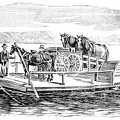An experiment was made by Patrick Miller, a banker in Edinburgh, aided by Mr. Taylor, tutor in his family, and Alexander Symington, a practical engineer. Mr. Miller had a boat built and fitted with a small steam-engine, for his amusement, on Dalswinton Loch, Dumfriesshire. It was a twin-boat, the engine being placed on one side, the boiler on the other, and the paddle-wheel in the centre. It was launched in October, 1788, and attained a speed of five miles an hour. The engine, of one horse-power, is still to be seen in the Andersonian Museum, in Glasgow. Encouraged by his experiment, Mr. Miller bought one of the boats used on the Forth and Clyde Canal, and had a steam-engine constructed for it by the Carron Ironworks Company, under Symington’s superintendence. On December 26th, 1789, this steamboat towed a heavy load on the canal, at a speed of seven miles an hour; but, strange to say, the experiment was dropped as soon as it was tried.
- Author
- Steam Navigation and Its Relation to the Commerce of Canada and the United States
By James Croil
Published in 1898
Available from gutenberg.org - Posted on
- Wednesday 24 February 2021
- Dimensions
- 750*1013
- Tags
- Boats, Century:18th
- Albums
- Technology / Transport / Water
- Visits
- 746
- Downloads
- 21
 Download Photo
Download Photo





